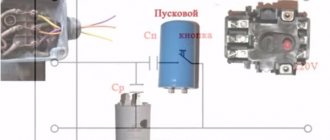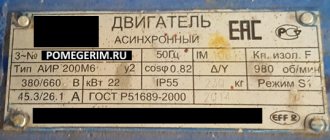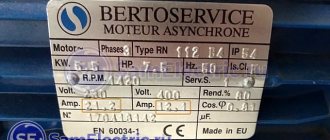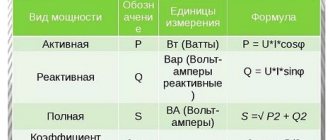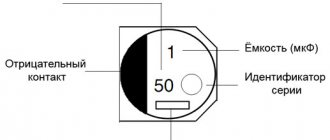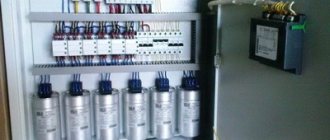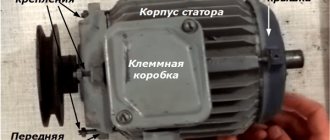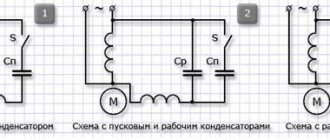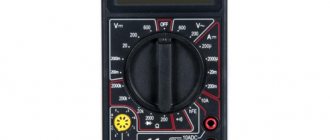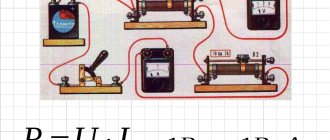When designing electrical wiring in a room, you need to start by calculating the current strength in the circuits. An error in this calculation can be costly later. An electrical outlet can melt if exposed to too much current. If the current in the cable is greater than the calculated current for a given material and core cross-section, the wiring will overheat, which can lead to melting of the wire, a break or short circuit in the network with unpleasant consequences, among which the need to completely replace the electrical wiring is not the worst thing.
It is also necessary to know the current strength in the circuit to select circuit breakers, which should provide adequate protection against network overload. If the machine is set with a large margin at its nominal value, by the time it is triggered, the equipment may already be out of order. But if the rated current of the circuit breaker is less than the current that appears in the network during peak loads, the circuit breaker will drive you crazy, constantly cutting off power to the room when you turn on the iron or kettle.
Formula for calculating the power of electric current
According to Ohm's law, current (I) is proportional to voltage (U) and inversely proportional to resistance (R), and power (P) is calculated as the product of voltage and current. Based on this, the current in the network section is calculated: I = P/U.
In real conditions, one more component is added to the formula and the formula for a single-phase network takes the form:
and for a three-phase network: I = P/(1.73*U*cos φ),
where U for a three-phase network is assumed to be 380 V, cos φ is the power factor, reflecting the ratio of the active and reactive components of the load resistance.
For modern power supplies, the reactive component is insignificant; the value of cos φ can be taken equal to 0.95. The exception is powerful transformers (for example, welding machines) and electric motors; they have high inductive reactance. In networks where it is planned to connect such devices, the maximum current should be calculated using a cos φ coefficient of 0.8, or the current should be calculated using the standard method, and then a multiplying factor of 0.95/0.8 = 1.19 should be applied.
Substituting the effective voltage values of 220 V/380 V and a power factor of 0.95, we obtain I = P/209 for a single-phase network and I = P/624 for a three-phase network, that is, in a three-phase network with the same load, the current is three times less. There is no paradox here, since three-phase wiring provides three phase wires, and with a uniform load on each phase it is divided into three. Since the voltage between each phase and working neutral wires is 220 V, the formula can be rewritten in another form, so it is more clear: I = P/(3*220*cos φ).
Measuring power with a wattmeter
The power consumption of three-phase current is measured using wattmeters. This can be a special wattmeter for a 3-phase network, or a single-phase one connected according to a specific circuit. Modern electricity metering devices are often made using digital circuitry. Such designs are characterized by high measurement accuracy and greater capabilities for operating with input and output data.
Three-phase digital wattmeter
Measurement options:
- Star connection with neutral conductor and symmetrical load - the measuring device is connected to one of the lines, the readings taken are multiplied by three.
- Asymmetrical current consumption in a star connection - three wattmeters in the circuit of each phase. The wattmeter readings are summed up;
- Any load and delta connection - two wattmeters connected in a circuit of any two loads. The wattmeter readings are also summed up.
Measurement schemes
In practice, they always try to make the load symmetrical. This, firstly, improves network parameters, and secondly, simplifies the accounting of electrical energy.
Selecting the rating of the circuit breaker
Applying the formula I = P/209, we find that with a load with a power of 1 kW, the current in a single-phase network will be 4.78 A. The voltage in our networks is not always exactly 220 V, so it would not be a big mistake to calculate the current strength with a small margin like 5 A for every kilowatt of load. It is immediately clear that it is not recommended to connect an iron with a power of 1.5 kW to an extension cord marked “5 A”, since the current will be one and a half times higher than the rated value. You can also immediately “graduate” the standard ratings of the machines and determine what load they are designed for:
- 6 A – 1.2 kW;
- 8 A – 1.6 kW;
- 10 A – 2 kW;
- 16 A – 3.2 kW;
- 20 A – 4 kW;
- 25 A – 5 kW;
- 32 A – 6.4 kW;
- 40 A – 8 kW;
- 50 A – 10 kW;
- 63 A – 12.6 kW;
- 80 A – 16 kW;
- 100 A – 20 kW.
Using the “5 amperes per kilowatt” technique, you can estimate the current strength that appears in the network when connecting household devices. You are interested in peak loads on the network, so for the calculation you should use the maximum power consumption, not the average. This information is contained in the product documentation. It is hardly worth calculating this indicator yourself by summing up the rated powers of the compressors, electric motors and heating elements included in the device, since there is also such an indicator as the efficiency factor, which will have to be assessed speculatively with the risk of making a big mistake.
When designing electrical wiring in an apartment or country house, the composition and passport data of the electrical equipment that will be connected are not always known for certain, but you can use the approximate data of electrical appliances common in our everyday life:
- electric sauna (12 kW) - 60 A;
- electric stove (10 kW) - 50 A;
- hob (8 kW) - 40 A;
- instantaneous electric water heater (6 kW) - 30 A;
- dishwasher (2.5 kW) - 12.5 A;
- washing machine (2.5 kW) - 12.5 A;
- Jacuzzi (2.5 kW) - 12.5 A;
- air conditioner (2.4 kW) - 12 A;
- Microwave oven (2.2 kW) - 11 A;
- storage electric water heater (2 kW) - 10 A;
- electric kettle (1.8 kW) - 9 A;
- iron (1.6 kW) - 8 A;
- solarium (1.5 kW) - 7.5 A;
- vacuum cleaner (1.4 kW) - 7 A;
- meat grinder (1.1 kW) - 5.5 A;
- toaster (1 kW) - 5 A;
- coffee maker (1 kW) - 5 A;
- hair dryer (1 kW) - 5 A;
- desktop computer (0.5 kW) - 2.5 A;
- refrigerator (0.4 kW) - 2 A.
How to measure power of different types
Measurement of different power types occurs according to formulas derived from the end of the last century and the century before last. Each variety has its own exact algebraic rule. So, you can measure the mechanical one using the first formula, and the electrical one using the second. As for the hydraulic one, it can be calculated using the third algebraic rule.
Measuring using formulas
Mechanical
Mechanical power is the scalar form of the product of the force vector and the speed vector at which some object is moving. Based on the formula for calculating this indicator, in order to find it, you need to know the indicator of the force vector with the speed vector, and the last of them is equal to the magnitude of the force multiplied by the magnitude of the velocity and the vector angle of the velocity with the force.
Regarding the calculation of a body that performs rotational movements, it can be noted that you need to have an idea of the indicator of the moment of force with angular velocity.
Additional Information! If this data is unknown in the problem, you can multiply the double number Pi by the rotation speed per minute at the moment of force, and then divide the obtained information by 60. In this way, calculations are made in mechanics if you need to understand what force an engine or other power unit has.
Electric
Electrical power is a quantity that shows the speed or transformation at which electrical energy moves. To study the instantaneous electrical power characteristic in a certain section of the circuit, it is necessary to know the value of the current and voltage of the instantaneous current and multiply these values.
To understand how much the active, total, reactive or instantaneous reactive power indicator is, you need to know the exact numbers of current amplitude, voltage amplitude, angle of current with voltage, as well as angular velocity and time, since all existing physical formulas are reduced to these parameters. The formulas also use the sine, cosine of the angle and the value 1/2.
Electric power concept
Hydraulic
The hydraulic power indicator in a hydraulic machine or hydraulic cylinder is the product of the machine pressure drop and the liquid flow rate. Typically this is the basic formulation taken from the only existing formula for the calculation.
Note! More algebraic and engineering rules can be found in the applied science of the movement of liquids and gases, namely in hydraulics
Direct and alternating current
As for direct and alternating current power, they are most often classified as the electrical variety. There is no specific concept for the two varieties, but they can be calculated based on existing algebraic settings. Thus, direct current power is the product of current and constant voltage, or twice the current and electrical resistance, which, in turn, is calculated by dividing twice the voltage by the usual resistance.
As for alternating current, this is the product of the current strength with the voltage and the cosine of the phase shift. In this case, only the active and reactive varieties can be easily counted. You can find out the full power value through the vector dependence of these indicators and area.
To measure these indicators, you can use both the above instruments and a phase meter. This device is used to calculate the reactive variety according to the state standard.
Concept of variable current power
In general, power is a quantity whose main purpose is to show the strength of a particular device and, in many cases, the speed of activity interacting with it. It can be mechanical, electrical, hydraulic and for direct current and alternating current. Measured according to the international system in watts and kilowatts. The instruments for calculating it are a voltmeter and a wattmeter. The basic formulas for independent calculations are listed above.
Calculation of power by current and voltage
This calculation occurs based on the actual power; it must be done before you start designing your home (house, apartment).
- This value determines the cables that power the devices that are connected to the electrical network.
- Using the formula, you can calculate the current strength; for this you need to take the exact network voltage and the load of the powered devices. Its size gives us an idea of the cross-sectional area of the veins.
If you know all the electrical appliances that should be powered from the network in the future, then you can easily make calculations for the power supply diagram. The same calculations can be performed for production purposes.
Single-phase 220 volt network
Current formula I (A - amperes):
Where P is the electrical full load (its designation must be indicated in the technical data sheet of this device), W - watt;
U—mains voltage, V (volts).
The table shows the standard loads of electrical appliances and the current they consume (220 V).
| electrical appliance | Power consumption, W | Current strength, A |
| Washing machine | 2000 – 2500 | 9,0 – 11,4 |
| Jacuzzi | 2000 – 2500 | 9,0 – 11,4 |
| Electric floor heating | 800 – 1400 | 3,6 – 6,4 |
| Stationary electric stove | 4500 – 8500 | 20,5 – 38,6 |
| microwave | 900 – 1300 | 4,1 – 5,9 |
| Dishwasher | 2000 — 2500 | 9,0 – 11,4 |
| Freezers, refrigerators | 140 — 300 | 0,6 – 1,4 |
| Electric meat grinder | 1100 — 1200 | 5,0 — 5,5 |
| Electric kettle | 1850 – 2000 | 8,4 – 9,0 |
| Electric coffee maker | 6з0 — 1200 | 3,0 – 5,5 |
| Juicer | 240 — 360 | 1,1 – 1,6 |
| Toaster | 640 — 1100 | 2,9 — 5,0 |
| Mixer | 250 — 400 | 1,1 – 1,8 |
| Hairdryer | 400 — 1600 | 1,8 – 7,3 |
| Iron | 900 — 1700 | 4,1 – 7,7 |
| Vacuum cleaner | 680 — 1400 | 3,1 – 6,4 |
| Fan | 250 — 400 | 1,0 – 1,8 |
| TV | 125 — 180 | 0,6 – 0,8 |
| Radio equipment | 70 — 100 | 0,3 – 0,5 |
| Lighting devices | 20 — 100 | 0,1 – 0,4 |
What is rated power?
This definition refers to an established indicator that allows you to connect a certain number of pieces of equipment at the same time. If you exceed their permissible number, the automatic protective system may fail. The calculation of installed power is carried out by summing this indicator, which characterizes each connected device in the system.
Important! The interfloor space of a residential building is equipped with an electrical panel and an input device, from which cables are laid to each apartment. In the case when the system is located in a residential area, a cable with the required cross-section is laid in it
To protect the distribution lines, an automatic machine, a counting device and a shield are installed to evenly distribute the loads on each line.
Electrical panel
Current calculation
The current value is calculated by power and is necessary at the design (planning) stage of a dwelling - apartment, house.
- The choice of power cable (wire) through which power consumption devices can be connected to the network depends on the value of this value
- Knowing the voltage of the electrical network and the full load of electrical appliances, you can use the formula to calculate the strength of the current that will need to be passed through the conductor (wire, cable). The cross-sectional area of the cores is selected based on its size.
If the electrical consumers in the apartment or house are known, it is necessary to perform simple calculations in order to correctly install the power supply circuit.
Similar calculations are performed for production purposes: determining the required cross-sectional area of the cable cores when connecting industrial equipment (various industrial electric motors and mechanisms).
Instruments for measuring quantities
Measurements of electrical quantities are made with special devices. Current is measured with an ammeter, voltage with a voltmeter, and power can be measured with a wattmeter, or calculated using a formula from the values of the first two values.
Using an online calculator, you can calculate not only the current at a known consumer power, but also the cross-section of the wires needed for electrical wiring.
Calculating the current strength and wiring parameters according to the power of electricity consumers is a very important part of the design of a building or apartment, so you need to approach this carefully and responsibly.
Useful tips Connection diagrams Principles of operation of devices Main concepts Meters from Energomer Precautions Incandescent lamps Video instructions for the master Testing with a multimeter
Single-phase network voltage 220 V
Current strength I (in amperes, A) is calculated using the formula:
I=P/U,
where P is the electrical full load (must be indicated in the technical data sheet of the device), W (watt);
U – voltage of the electrical network, V (volts).
The table below shows the load values of typical household electrical appliances and the current they consume (for a voltage of 220 V) .
| electrical appliance | Power consumption, W | Current strength, A |
| Washing machine | 2000 – 2500 | 9,0 – 11,4 |
| Jacuzzi | 2000 – 2500 | 9,0 – 11,4 |
| Electric floor heating | 800 – 1400 | 3,6 – 6,4 |
| Stationary electric stove | 4500 – 8500 | 20,5 – 38,6 |
| microwave | 900 – 1300 | 4,1 – 5,9 |
| Dishwasher | 2000 — 2500 | 9,0 – 11,4 |
| Freezers, refrigerators | 140 — 300 | 0,6 – 1,4 |
| Electric meat grinder | 1100 — 1200 | 5,0 — 5,5 |
| Electric kettle | 1850 – 2000 | 8,4 – 9,0 |
| Electric coffee maker | 6з0 — 1200 | 3,0 – 5,5 |
| Juicer | 240 — 360 | 1,1 – 1,6 |
| Toaster | 640 — 1100 | 2,9 — 5,0 |
| Mixer | 250 — 400 | 1,1 – 1,8 |
| Hairdryer | 400 — 1600 | 1,8 – 7,3 |
| Iron | 900 — 1700 | 4,1 – 7,7 |
| Vacuum cleaner | 680 — 1400 | 3,1 – 6,4 |
| Fan | 250 — 400 | 1,0 – 1,8 |
| TV | 125 — 180 | 0,6 – 0,8 |
| Radio equipment | 70 — 100 | 0,3 – 0,5 |
| Lighting devices | 20 — 100 | 0,1 – 0,4 |
The figure shows a diagram of the power supply device for an apartment with a single-phase connection to a 220 V network .
As can be seen from the figure, various electricity consumers are connected through corresponding machines to an electric meter and then to a general machine, which must be designed for the load of devices with which the apartment will be equipped. The wire that supplies power must also satisfy the load of energy consumers.
Below is a table for hidden wiring with a single-phase apartment connection diagram for selecting wires at a voltage of 220 V
| Wire core cross-section, mm 2 | Conductor core diameter, mm | Copper conductors | Aluminum conductors | ||
| Current, A | Power, W | Current, A | power, kWt | ||
| 0,50 | 0,80 | 6 | 1300 | ||
| 0,75 | 0,98 | 10 | 2200 | ||
| 1,00 | 1,13 | 14 | 3100 | ||
| 1,50 | 1,38 | 15 | 3300 | 10 | 2200 |
| 2,00 | 1,60 | 19 | 4200 | 14 | 3100 |
| 2,50 | 1,78 | 21 | 4600 | 16 | 3500 |
| 4,00 | 2,26 | 27 | 5900 | 21 | 4600 |
| 6,00 | 2,76 | 34 | 7500 | 26 | 5700 |
| 10,00 | 3,57 | 50 | 11000 | 38 | 8400 |
| 16,00 | 4,51 | 80 | 17600 | 55 | 12100 |
| 25,00 | 5,64 | 100 | 22000 | 65 | 14300 |
As can be seen from the table, the cross-section of the cores depends, in addition to the load, on the material from which the wire is made.
Three-phase or single-phase connection
In the network, the windings are shifted by 120 degrees. If you imagine this shift in the form of 2 rotating vectors, they are also placed at the same degree of inclination.
And the linear voltage will not equal the sum of the vectors. In other words, imagine a right angle (equal to 90 degrees), the lines of which are 220 V. If they are connected to form a complete triangle, the distance for the connection will be equal to 380 V, as shown in the photo below.
The network connection was already sorted out at the top. Nothing was said about connecting a single-phase device. But you already know that a single-phase one has as many as 4 connection wires, unlike a device with three phases.
- Phase power is supplied to the first terminal.
- The second terminal is the load output of the electrical consumer.
- Zero falls on the third terminal.
- The zero output is fed to the fourth.
Those. the first and second wires pass through the machine and enter the apartment itself. And the remaining 2 fall on zero grounding. Examples of single-phase consumers are sockets.
Determining the power of an electric motor without a tag
If there is no technical certificate or tag on the engine, the question arises: how to find out the power of an electric motor without a plate or technical documentation? The most common and fastest methods, which we will discuss in the article:
- According to shaft diameter and length
- By dimensions and mounting dimensions
- By winding resistance
- By no-load current
- By current in the terminal box
- Using an induction meter (for household electric motors)
Determining engine power by shaft diameter and length
The simplest ways to determine the power and brand of an engine are the overall dimensions - shaft or mounting holes. The table shows the lengths and diameters of the shafts (D1) and length (L1) for each model of an asynchronous industrial three-phase motor. Go to detailed overall dimensions of AIR electric motors
| R, kW | 3000 rpm min | 1500 rpm min | 1000 rpm min | 750 rpm min | ||||
| D1, mm | L1, mm | D1, mm | L1, mm | >D1, mm | L1, mm | D1, mm | L1, mm | |
| 1,5 | 22 | 50 | 22 | 50 | 24 | 50 | 28 | 60 |
| 2,2 | 24 | 28 | 60 | 32 | 80 | |||
| 3 | 24 | 32 | 80 | |||||
| 4 | 28 | 60 | 28 | 60 | 38 | |||
| 5,5 | 32 | 80 | 38 | |||||
| 7,5 | 32 | 80 | 38 | 48 | 110 | |||
| 11 | 38 | 48 | 110 | |||||
| 15 | 42 | 110 | 48 | 110 | 55 | |||
| 18,5 | 55 | 60 | 140 | |||||
| 22 | 48 | 55 | 60 | >140 | ||||
| 30 | 65 | |||||||
| 37 | 55 | >60 | 140 | 65 | 75 | |||
| 45 | 75 | 75 | ||||||
| 55 | 65 | 80 | 170 | |||||
| 75 | 65 | 140 | 75 | 80 | 170 | |||
| 90 | 90 | |||||||
| 110 | 70 | 80 | 170 | 90 | ||||
| 132 | 100 | 210 | ||||||
| 160 | 75 | 90 | 100 | 210 | ||||
| 200 | ||||||||
| 250 | 85 | 170 | 100 | 210 | ||||
| 315 | — | — | ||||||
Check power by dimensions and mounting dimensions
Table for selecting engine power based on mounting holes on the feet (L10 and B10):
How to calculate?
The calculation of the power of a three-phase network is calculated as follows: I=P/U. This is the most primitive formula used in schools.
The general calculation is based on the following notation: Ptot = Uа∙Iа∙cosа+ Ub∙Ib∙cosb+ Uc∙Ic∙cosc. Here cos denotes changes in P, and the letters next to it are the very phases that run next to the lines.
